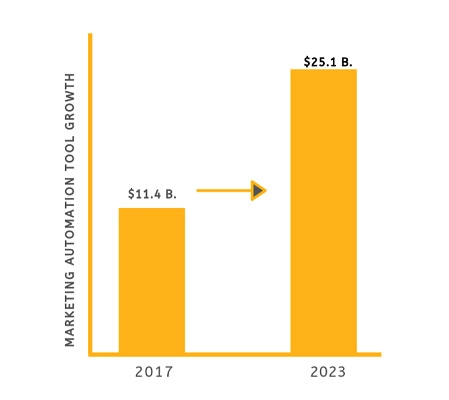
Introduction
Successful B2B marketing automation requires thoughtful planning, but once you’re ready to launch, it can take your sales funnel to the next level.
Without using a predetermined workflow, your salespeople are like an army of blindfolded men, throwing spaghetti against a wall littered with failed campaigns and random leads.
No matter what business you’re in, marketing automation allows you to get more qualified leads for your sales funnel.
In fact, Forrester predicts that business spending for marketing automation will reach $25.1 billion annually by 2023.

Source: Forrester
So, what does marketing automation look like in practice? Let’s start with the basics.
What is B2B Marketing Automation?
B2B Marketing automation is a set of tools integrated into your marketing and sales system to make it easier to manage leads, nurture relationships, and close more deals.
By understanding a lead’s preferences over time, you can personalize your interactions with them and present them targeted content, taking the pain out of lead nurturing. This content can be fed to your sales team, helping them identify the highest quality leads.
How Does Marketing Automation Work?
- To start with, your B2B marketing automation platform will provide a section of codes that will go at the backend of your website’s code.
- This code will allow your B2B marketing automation platform to keep a record of every visitor that drops by your website. And that includes their behavior, traffic source, and every detail they provide to your business
- You can view each visitor’s data individually from your automation platform.
- You can also manually set up personalized lists based on your business demands (for example, their engagement pattern, demographics, etc.) and segment your visitors accordingly.
- These workflows allow you to set up automatic actions based on specific user conditions. For example, you can send follow-up emails to anyone who hasn’t engaged with your website in a week. You could also create a new lead on your database for anyone visiting but not converting within 2 minutes and more.
To ensure that your strategies produce the highest quality leads, you need to focus on lead nurturing and scoring.
How do you do that?
Simple, you’ll need to build an automated marketing workflow that can help you establish specific processes for each stage of the buyer journey. Following which, you’ll need to create a set of reliable triggers that will execute those workflows at the right time.
B2B Marketing Automation Workflows that Works Every Time
If you are a newbie to the world of marketing automation, here’s how you can generate more deals:
1. Lead Nurturing
By nurturing leads with automated emails, you can deliver consistent, personalized content that educates and turns them into loyal customers.
Therefore, don’t let those hot leads get away! Set up an automated workflow that emails your sales team when prospects reach “hot” status. Yes, hot.
Don’t worry; you don’t need to work out the details of what makes one lead hot and another not. Everyone knows that only the highest scoring leads should talk to sales.
The best email B2B marketing automation workflow should include looking somewhat like this:

Source: Sendinblue
- A sequence of welcome emails to introduce your new subscribers to your product or service.
- A sequence of emails with gated content like free ebooks or webinar signups.
- A sequence of customized emails based on lead activities like page visits, email opens, and clicks.
2. Re-Engagement
“Leads are fickle, so they forget about you even faster!”
So, don’t worry if you have followed up with potential clients and they go quiet. Sometimes, moving a deal forward is an uphill task and is easier if you inject some fun back into the process!
Give it another shot, try a different approach, be creative in how you remind your prospects that you are there to help them.
Think about how you might be able to engage your contact again. Then use features like behavioral automation triggers in your software to automate sending the right content to re-engage them.
3. Lead Scoring
B2B leads need to be nurtured, just like people too! By this, we mean – knowing where a lead is in the buyer journey. This will allow you to qualify it more accurately and tailor your message appropriately.
“For a B2B marketer whose job is to send high-quality leads to sales, timing is key.”
A great way to ensure that you’re getting the most out of your marketing efforts is to use lead scoring models. These help you accumulate and score your leads based on their level of engagement.
Once you have your leads scored, it will become simpler for you to focus your attention on the more engaged leads first, helping your organization grow even faster.
4. Assign Leads to Sales Reps
It’s a fundamental job of a company to nurture its audience with relevant content along the sales funnel. From nurturing to initiating engagement and interest, the collaboration between B2B marketing automation and sales is vital for leading higher funnel activities.
One of the most significant elements of marketing automation is that it allows technology to nurture your leads as far as possible through the purchase process. That way, your sales rep can intervene only when absolutely necessary.
5. Multi-Channel Campaigns
Targeted communications are the foundation of effective B2B marketing automation. Therefore, create engaging and relevant communications triggered by prospect behavior across different channels. This will help you achieve better results and build your brand at the same time.
However, if you’re new to B2B marketing automation, master one channel at a time. Email nurturing programs can be a simple way to get started.
Once you’re more comfortable, it’s time to try a multi-channel approach.
Multi-channel automation is a combination of multi-layered marketing interventions implemented over time to maximize lead nurturing and conversion. As the name suggests, this digital marketing strategy targets leads at various touchpoints throughout the buyer journey.
These touchpoints could be anything, from email, SMS, or retargeting ads on social media sites. Experiment to figure out what works best for your business.

Source: Sendinblue
6. Progressive Profiling
No matter how complex a business process is, B2B marketing automation can simplify it, and that’s where progressive profiling comes in.
It looks beyond initial interactions between a user and your brand. It understands what the user wants and works to provide it, adding more value with every interaction.
When you need to create ten landing pages for your business, it can get tricky to know what questions to put on which landing pages. But, unfortunately, doing that without any guidance isn’t an option.
The questions you ask must progress in such a way that you’re covering all the relevant reasons why prospects need your product or service.
“Marketing automation is one of those things that will drastically increase your business’ efficiency and allow it to scale.” You can set up custom contact fields that are only relevant based on where the lead came from.
For example, suppose it’s a LinkedIn lead who came in through the link to one of your job postings. In that case, you can ask if they’d be interested in a position at your company and then automatically send them to a pre-populated form with that information.
7. Lead Routing
Your sales team has a lot on its plate, and it’s important to stay focused. Lead routing is a B2B marketing automation workflow that directs leads to the right sales reps based on commonality in fields like products, services, or territories.
If you have territory-based divisions (sales team divided by geographic location, for example), use lead routing to automatically forward leads to the correct sales rep.
Next up, if you’re dividing leads based on products or services (for example, a rep just focusing on B2B versus B2C products), you can use lead routing to easily route leads based on “product” or “service” form field.
8. Data Governance and Management
It’s also good practice to ensure your CRM stays up to date. Using automated workflows is a super-easy way to ensure that happens! For example:
- Opt-outs: To add a contact to the opt-out list, you can create a workflow stating if a contact opts out of communication, it is automatically added to a list called “Opt-outs.”
- Subscription types: You can set up front-end workflows for traffic, such as newsletters, webinars, etc., to manage their subscriptions on the back end.
- Contact owner: You can use workflows to ensure that all contacts have an owner. That way, you’ll know that all leads are being consistently followed up with and contacted by a sales professional.
Take Your B2B Marketing Automation Practices to the Next Level
Too many marketers have a one-size-fits-all approach to marketing automation. This is crazy because everyone’s different – we all need our own lead generation strategy.
These B2B marketing automation workflows will lay the groundwork for quicker sales impact.
In this article, we’ve looked at everything from why you should automate your B2B marketing to specific workflows you can implement to make your strategies more effective.
Now that you’ve learned about all the different possibilities of marketing automation, it’s time to get these into action.
If you know of any other practice, we’d love to read those in the comments section below.
Our blog
Latest blog posts
Tool and strategies modern teams need to help their companies grow.

In the absence of a solid lead scoring system, your sales team will spend time pursui...

Programmatic ABM combines the effectiveness of targeted engagement with automation. I...

Take advantage of the year-end holiday rush so you can boost your SaaS revenue and st...





